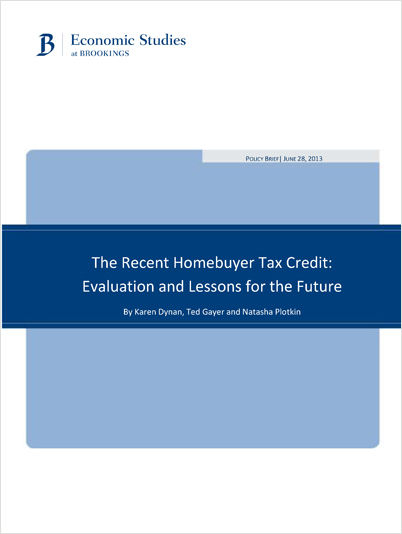 In an in-depth study of the federal homebuyer tax credit and complementary state-level initiatives, we look at how the programs were structured and, based on their features, what effects one would expect on the economy. We also look for evidence of how the programs affected housing market conditions, both while in progress and after they ended. Using a variety of analytical techniques, we find that these initiatives likely provided a modest short-term boost to housing demand, but that some of these effects were reversed after the expiration of the credits.
In an in-depth study of the federal homebuyer tax credit and complementary state-level initiatives, we look at how the programs were structured and, based on their features, what effects one would expect on the economy. We also look for evidence of how the programs affected housing market conditions, both while in progress and after they ended. Using a variety of analytical techniques, we find that these initiatives likely provided a modest short-term boost to housing demand, but that some of these effects were reversed after the expiration of the credits.
Based on our study, we offer the following lessons to future policymakers contemplating the use of a homebuyer tax credit as a stabilization tool:
- When offered on a time-limited basis, a homebuyer tax credit will to some extent “pull forward” sales that would have occurred anyways. As a result, a time-limited credit will typically be followed by a period of partial “payback.” However, there can be benefits to accelerating economic activity if the costs of an economic slump increase disproportionately with its size.
- To induce a net increase in the demand for owner-occupied homes, a homebuyer tax credit should target first-time homebuyers. There may be little or no additional demand associated with purchases by households that already own a home (such as the repeat buyers who took advantage of the WHBAA credit) because they are likely to be selling a home at the same time. Consideration should also be given to the implications for the rental market, as many first-time homebuyers may be leaving a home they rented.
- Homebuyer tax credit programs have important distributional effects. Future policy discussions need to consider the desirability of such effects.
- The benefits from any boost to economic activity associated with a homebuyer tax credit need to be weighed against alternative uses of the funds. More research is not only needed on the benefits of the homebuyer tax credit but also on the benefits associated with other forms of economic stimulus compared to the costs of such policies.
- Complementary programs that allow homebuyers to “monetize” their homebuyer tax credits sooner (such as the bridge loan programs offered by states and the FHA) should facilitate home purchases by cash-constrained households and, in turn, increase the impact of a credit. Our analysis found little evidence that these programs made a difference in the recent episode, but further study is warranted.
- The state-level programs that were somewhat similar in structure to the federal program (offering grants or credits) yielded clearer evidence of a modest impact on housing market conditions than the federal programs. This may be a result of having better variation with which to test for effects, but it could also reflect a better ability by states to design programs that are tailored to the specific conditions prevailing in their own housing markets. Future research on this topic is also warranted.
The Brookings Institution is committed to quality, independence, and impact.
We are supported by a diverse array of funders. In line with our values and policies, each Brookings publication represents the sole views of its author(s).





